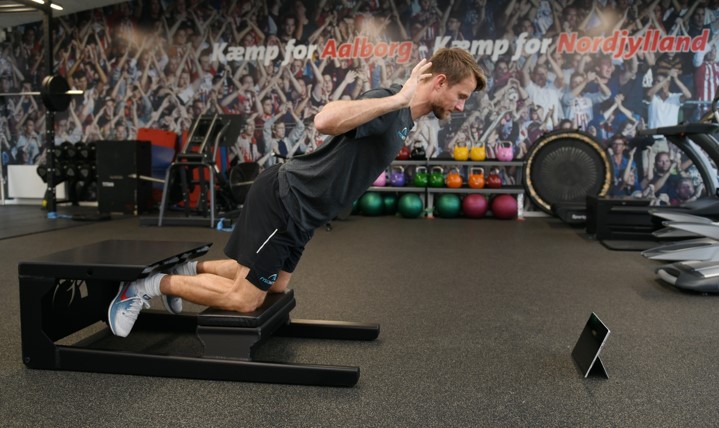Read about the latest FysioMeter news, developments and relevant research

Martin Jørgensen
CEO FysioMeter ApS
Sports Physiologist, Ph.D
Senior Scientist at Aalborg University Hospital

Cost and prevalence of hamstring strain injuries
Did you know…
… that hamstring strain injury (HSI) is the most prevalent injury in running-based sports (1, 2)?
… and that HSIs account for 12-16% of all injuries in football (1)?
In professional football, one in five players will suffer an HSI in any given season (2). However, despite increasing knowledge of HSIs, the injury rate in football is increasing (3). HSI, therefore, represents a critical burden in regards to health, performance and economy in football (1).
In professional football, an HSI injury will result in approximately 17 days lost from practice and competition, and the estimated cost per injury for elite European football clubs is as much as €280,000 (2).
The cause of HSI is multifactorial, but a critical modifiable risk factor is overall strength concerning injury prevention (2). Also, bilateral hamstring strength asymmetries have been shown to increase the risk of HSI in high-speed running sports (4, 1), and lower pre-season hamstring strength is associated with a heightened risk of HSI during the competitive season (4).
Large-scale intervention studies using the Nordic hamstring exercise have reported 50-70% reductions in HSIs in both elite and sub-elite soccer players when athletes are compliant (5,6). Petersen et al. assigned a 10-week Nordic hamstring training programme to 943 sub-elite Danish soccer players and reported 71% less first-time and 85% fewer recurrent HSIs in the Nordic hamstring training group(5). Besides, van der Horst and colleagues assigned at similar 13-week Nordic hamstring strengthening programme to 597 sub-elite Dutch soccer players and found that players who were compliant with the training had 68% fewer hamstring strains than those who were not (6).
Furthermore - did you know that the recurrence rate of HSIs is relatively high (14-63%) (1, 7)? Recurrent injuries require more rehabilitation that the primary injury, and therefore reducing the risk of recurrent injuries are crucial.
Studies have shown that one-time-only pre-season screening for HSI risk factors is of limited value for preventing hamstring injuries (8), and therefore, in-season monitoring is recommended as a secondary strategy for HSI prevention (9). Since an athlete's isometric knee flexion strength may decrease before suffering an HSI (10), regular monitoring of hamstring strength may be of great value. Additionally, monitoring and identifying post-match impairments in-season allows for early intervention and thereby lower the susceptibility of HSI (9).
… and did you know that all this is possible with FysioMeter?
FysioMeter’s H-station allows you to;
- Test your athletes overall dynamic and isometric hamstring strength
- Check for bilateral hamstring strength asymmetries
- Plan and perform individualized or evidence-based training programs
- Keep track of your athletes’ compliance to ordinated programs
- Monitor and identify which athletes are at risk of injury
For more information contact FysioMeter at info@fysiometer.dk
References
(1) Markovic G, Sarabon N, Boban F, Zoric I, Jelcic M, Sos K, Scappaticci M. Nordic hamstring strength of highly trained youth football players and its relation to sprint performance. J Strenght Cond Res, 2018
(2) Bourne MN, Timmins RG, Opar DA, Pizzari T, Ruddy JD, Sims C, Williams MD, Shield AJ. An evidence-based framework for strengthening exercises to prevent hamstring injury. Review article. Sports Med, 48:251-267, 2018.
(3) Buckthorpe M, Wright S, Bruce-Low S, Nanni G, Sturdy T, Gross AS et al. Recommendations for hamstring injury precention in elite football: translating research into practice. Br J Sports Med, 2018.
(4) Wollin M, Thorborg K, Pizzari T. The acute effect of match play on hamstring strength and lower limb flexibility in elite youth football players. Scand J Med Sci Sports 2017;27:282–8.
(5) Petersen J, Thorborg K, Nielsen MB, et al. Preventive effect of eccentric training on acute hamstring injuries in men’s soccer: a cluster-randomized controlled trial. Am J Sports Med. 2011;39(11):2296–303.
(6) van der Horst N, Smits DW, Petersen J, et al. The preventive effect of the Nordic hamstring exercise on hamstring injuries in amateur soccer players: a randomized controlled trial. Am J Sports Med. 2015;43(6):1316–23.
(7) de Visser, HM, Reijman, M, Heijboer, MP, and Bos, PK. Risk factors of recurrent hamstring injuries: A systematic review. Br J Sports Med 46: 124–130, 2012.
(8) Schache AG, Crossley KM, Macindoe IG, et al. Can a clinical test of hamstring strength identify football players at risk of hamstring strain? Knee Surg Sports Traumatol Arthrosc 2011;19:38–41.
(9) Wollin M, Thorborg K, Drew M. A novel hamstring strain injury precvention system: post-match strength testing for secondary prevention in football. Br J Sports Med, 2019.
(10) Bahr R. Why screening tests to predict injury do not work-and probably never will…: a critical review. Br J Sports Med 2016;50:776–80.
